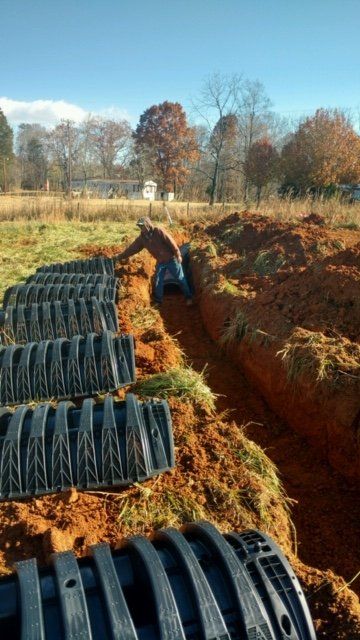Septic Replacement & Installation Services in Greensboro, NC
Aqua Drill, Inc. offers septic system installation and repair services for residential and commercial properties.
The septic system is an efficient, inexpensive, and convenient method for treating and disposing of household wastewater. There are many different types of septic systems with several different designs. The most common septic systems that we install are the conventional septic system, EZ Flow and Infiltrator reduction systems. Septic systems consist of three main parts, including the septic tank, the drain field and the soil beneath the drain field.
A septic tank is a watertight concrete box nearly nine feet long and 5 feet tall. It is usually buried near the home. Septic tanks are usually designed with a 1,000-gallon liquid capacity, though the size is legally determined by the number of bedrooms in the home. Household wastes are temporarily held in the tank while pretreatment takes place.
The tank is connected to the drain field by a buried pipe. Typically, drain fields consist of 2-5 trenches excavated in the soil. In conventional systems, the trenches are three feet wide and 2-3 feet deep, and 9 feet apart. Layers of washed gravel or stone are placed around a perforated distribution pipe.
The trenches of an EZ Flow system consist of tubing of mesh bags filled with foam beads surrounding a flexible perforated pipe. The trenches of an Infiltrator system consist of hollow structures manufactured of PolyTuff (a proprietary blend of recycled polyolefin plastic) that interlock together and attach end to end to form a continuous drainage area. EZ Flow and Infiltrator systems do not require gravel. The advantages of Infiltrator and EZ Flow systems include long-term savings due to longer life and greater operating efficiency, providing a greater treatment area to handle more wastewater with a higher efficiency, and offering a “greener” approach utilizing recycled plastic resins to manufacture the installation materials. Reduction systems are backed by a minimum of one year warranty and can be installed in tight, sloped, and curved areas creating less site disruption while using a minimum of 24% less land/surface area. After the trenches are covered with soil, the area must be landscaped to keep surface waters from ponding over the drain field.
The biggest purpose of the drain field is to deliver wastewater to the soil. The soil purifies the wastewater by removing the germs and chemicals before they reach groundwater or surface waters like lakes, rivers, and estuaries.
Septic System Pumping
It is recommended to pump your septic tank every 3 - 5 years. How often you pump, depends on the amount of water you use.
General rule of thumb: The more people using your septic system = increased water flow = your septic tank will fill up faster = more frequent pumping. It may be possible that the septic tank will need pumping more often than 3 - 5 years.
Alternative Septic Systems
There are more than 400 soil types found in North Carolina and usually more than one type is found within a one-acre lot. Many of these soils are unsuitable for conventional septic systems and may require an alternative septic system. If your site’s soil is not suitable for a conventional septic system, there are other types of systems available. Where soils are too wet or shallow, the drain field might be placed closer to the ground surface in the upper layers of the soil. Artificial drainage around the septic system is an option for wet soils.
If your soil is unsuitable for a conventional system you may need to hire a licensed soil scientist to engineer an alternative system.
Legal Septic Requirements
It is essential that your county environmental health specialist conduct a comprehensive soil and site evaluation to determine the type of septic system that will be required. A septic permit must be obtained and an authorization for wastewater construction or repair must be issues by the county health department before septic system installation or repair takes place.





